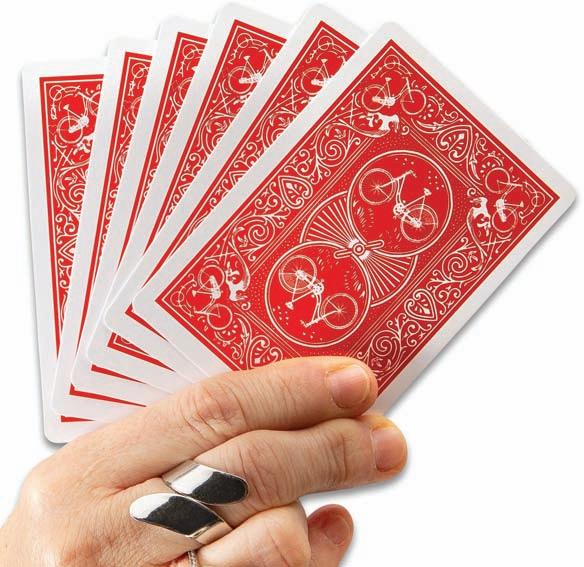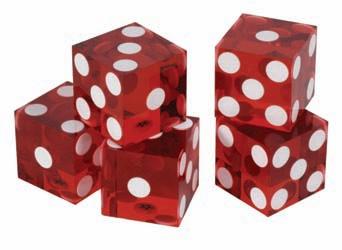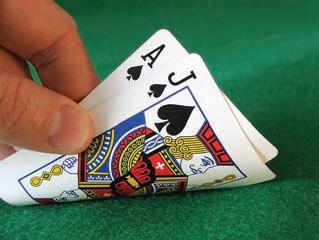
10 minute read
Old Scams, New Twists
Can casino operators stay one step ahead of the cheaters who use technology and ignorance of previous scams to become successful?
By Bill Zender
Advertisement
Many traditional table game scams have been eliminated due to advancement in technology. Where once the dealer held the blackjack deck in his hands, now almost all games are dealt from a dealing shoe. Unless modified in an unusual and obvious manner, the plastic shoe prevents a number of sleight-of-hand techniques once employed to steal money from the casino, as well as allow unsavory casinos to extract excessive money from the players.
In addition, shuffling machines and hole-card peeking devices have reduced other forms of cheating and advantage play that had plagued casinos in the past.
At one time, the only oversight on a gaming table was that of the consistent watch of the casino floor supervisor. Today, table games activity images are recorded using ample numbers of high-definition video cameras scattered across the casino ceiling. Surveillance expert George Lewis Jr. once called surveillance cameras “the eye that doesn’t blink.” They are the backbone of a system that oversees the operation and honesty of all casino games.
Training is another leap forward in table game protection. In years past, the mantra of many casino executives was to limit their staff to nothing more than the game protection basics. Their fear was that if you teach your subordinates what you know, then someday they might take your job.
A second fear existed in that, if you taught them about table game scams, what would prevent the employees from using that information against the house? Are you training for protection or opening a door to theft?
With information at everybody’s keyboard fingertips, failure to utilize game protection equipment and procedures, not placing more emphasis on video coverage and capabilities, and not training your floor and surveillance staff on methods for beating table games is a license for disaster.
By not taking these necessary steps, the casino executive enters the realm of “gambling” with the financial health of the casino.
Scams from the Past That Are Making a Comeback: Craps
Switching “gaffed” or altered dice into a modern casino crap game is considered a rarity of the past. The increase in the surveillance camera’s ability to record greater frames per second, table game training and procedures, and the fact that grabbing up “bad” dice from the cheaters is considered strong evidence, the switching of good dice for bad dice is all but unheard of.

Presenting physical evidence such as altered dice to a jury is considered a “slam-dunk” in obtaining a conviction in a court of law. The author has not known of altered dice being illegally used on a regulated crap game in North America since the turn of the millennium. In many of the author’s game protection seminars on craps, the topic of bad dice is not even discussed.
Switching dice in craps has been replaced by the “dice slide” or scoot. This is the act of controlling the outcome of one or both dice, by sliding the die down the layout in a manner where it will not turn over, maintaining a selected number. Although somewhat popular with unscrupulous dice shooters, sliding the dice in some jurisdictions is not considered cheating, and even when it is, it is very difficult to convince people on a jury that the required act of “throwing” the dice can be interpreted as illegal.
In recent years, even prior to Covid, casino executives have been looking for ways to reduce table game staffing. It began with the removal of a box person from the crap table. The box person was assigned the task of sitting on the game, protecting the physical bankroll of chips, dropping all received currency, watching for dealer mistakes or any cheating, and controlling the pace of the game.
To save payroll at several casinos, the box person has been pulled off the table, placed into a quasi-floor supervisor role, and usually given the responsibility of watching (and handling issues) on several table games in his or her casino floor area.
In addition, an old Northern Nevada procedure is resurging throughout North America, and that is the practice of removing one of the dealer positions from the revolving four-man crewed game. Today, it is not uncommon to see a craps table working with one less base dealer or without a stick dealer position.
This is known as “inside stick.” One of the base dealers uses the stick to move and call the dice. In some situations, casino management has functionally reduced the crap team on a table from three dealers and a box person to only two dealers with limited supervision. Is this payroll-based reduction ripe for problems such as dice switching and collusion with the customers?
If the electronic-based crap game Roll to Win Craps from Aruze is any indication, a peek into the crystal ball tells the curious executive that bad dice could be making a comeback. Roll to Win is a great game and serves as a wonderful segue to live craps. However, the people that design electronic simulation games fail to take into consideration several live game problems. Since its inception, the Roll to Win Craps game has been subject to several cheating and advantage play techniques:
• Dice sliding.
• Dice being purposely called wrong and input into the keypad incorrectly.
• Dealer distraction that results in an incorrect dice total being input into the keypad.
Why have these problems plagued this game? First, the game is dealt with only one dealer. The electronic table handles all the bets and bet payments like a slot machine, requiring a live dealer to only handle the stick, move the dice, call the dice, and input the outcome into a monitor/keypad. Sounds safe and easy, right?
The primary problem revolves around the lack of oversight on the game— one dealer and usually no supervisor. The game is still under surveillance, but not the same intense coverage as seen over its live-game equal.
In addition, some casinos do not assign someone with dice dealing experience to work the Roll to Win table. The author has witnessed several situations where management has placed a blackjack dealer with no dice experience on the game. Why not? The dealer does not have to make payoffs and handle chips. All they need to do is call the dice and input the number into a keypad. How can you tell a dealer has no dice experience? Just watch them use the stick to attempt to move the dice. For an experienced dice dealer, it is somewhat uncomfortable to watch. If this game with a limited-experience dealer and no floor supervision is not open for switching bad dice, what game is?
Using Old Scams to Attack Alternative Games: Card Switching and Card Marking
A cheater may not be able to pick up and handle cards in face-up dealt blackjack games, but what about other card-based games your casino offers? Any time players are allowed to touch and handle the playing cards, a few old-time scams are still possible. Are alternative games open to different forms of card switching and marking just like blackjack pitch games from years gone by?
Elbow-to-elbow switch in variations of Three Card or Four Card Poker
Do not think for a moment that card switching does not happen in alternative card games. The most common technique for specific card swapping is the “elbow-to-elbow” switch move. Two cheaters sit next to each other in the “later” wagering positions of the table. One cheater will wager near table minimum while the other cheater wagers close to or at table maximum. The object is for the lower-wagering player to provide the best possible card in his hand for the high-wagering cheater to use in their hand.
The alternative games that are most attractive are simple-format games where the players handle three or more cards and are structured with only one betting/folding cycle. The more cards the cheaters hold in their hands, the more possibilities they have for improving the high-wagering hand.
This one-card swap takes place almost immediately after the cheaters peek their hands, and takes from 6 to 10 seconds to complete. The scam usually takes a team of four cheaters: two cheaters to swap cards, one cheater to stand behind them at the table to block any possible view of the switch from behind them on the outside of the game, and a fourth cheater acting as a “distractor” sitting in one of the first seats on the table. The distractor’s function is very important since it is his job to keep the dealer occupied during the card-swapping process. Even though the card switch itself is not visible, the cheaters still do not want the dealer focusing on the actions of those two cheaters during the switching process.
From experience, the author has noted that cheaters tend to stay away from games where the players only receive two cards, and the game is subject to multiple betting rounds. The two-card games limit the cheaters on cardswapping options and the multiple betting rounds are due to additional card information being revealed which will change the individual hand possibilities during the game. Also, switching cards in the later betting rounds offers more situations where the swap move can be detected, since the bet/fold/check decision process provides less time to complete the switch.

Marking cards: Determining dealer hole-card information, community cards, including first card value
Card marking is always a possibility in games where the customers handle the cards. In an alternative game, the focus of marking cards is to provide the cheater with card information on the dealer’s hand and/or future information to be revealed on the community cards. This information is generally used when the cheater makes their bet/check/fold decision during the first betting round.
Under normal circumstances, a player only possesses information about cards in their hand. If the deck has been marked, information regarding yetto-be-exposed “key cards” will be known to the cheater, who will use this information to make more “educated” hand decisions. In many instances of card marking, the knowledgeable game protection professional will spot the marked card attack during the decision-making process of the cheaters during the decision round. Of course, this requires the casino personnel watching the game to have knowledge of the game’s basic or common strategy. Unfortunately, this is a floor supervisor and surveillance skill set that is lacking in too many situations.
Another form of marked card attack allows the cheater to gain information on the first hand dealt to the players, from the shuffling machine prior to hand delivery. If the first hand to be delivered from the shuffling machine is delivered to the first position on the table, cheaters could mark specific valuable cards, and when one of those cards is to be delivered to that first hand, the cheater receiving that hand will wager more money. Detection of this form of marked card cheating usually involves spotting a correlation between the increase in wager and the possession of a key card in the player’s hand.
The Forgotten Scam in Blackjack: Hole-Card Information
Prior to the 1980s, the most common practice for the dealer to peek their hole card in blackjack was by lifting the end of the up-card and hole card slightly up off the table and looking at the hole card’s value. This process had been used for decades. It was quick and simple, and provided the dealer with information on whether he or she held a hand-ending “two-card blackjack.” It also provided the dealer with information on all other two-card totals in his or her hand. This information could sometimes be gleaned by the knowledgeable player by interpreting the dealer’s unconscious body language or in some cases, information passed along by a dishonest dealer to an accomplice playing at the table.
Starting in the late ’80s, many casinos suspended this practice and simply opted to not look at the hole card. This eliminated any possible issues of giv- ing out hole-card information, but at the same time reduced numbers of rounds dealt an hour due to completing hands that had basically already been decided. By the 1990s, several different forms of hole-card reading devices had been developed, and the industry gravitated towards their use, of course for a small monthly fee.
The importance of the hole-card readers was twofold—they regained the lost hands per hour from not peeking the hole card and removed the threat of the dealer communicating hole-card information either unconsciously or intentionally. Note: Hole-card readers were also intended to eliminate the problem from unintentionally “marked” cards that occurred during the older peeking process known as “dealer bends.”
Exploiting the hole-card reader when having a low-value up-card
While the dealer still receives information about the value of the hole card and hand total using a reader, its use narrows this type of information. For example, if the dealer has a “10” value up-card, the dealer brings the up-card and hole card straight back and places the cards into the device. The device visually informs the dealer if the hole card is an Ace, giving the dealer a hand-ending blackjack. If the up-card is an Ace, the dealer turns the two cards 45 degrees and proceeds to use the device to see is the hole card is a 10. In both instances, the device does not give the dealer any other card value information.
Several years ago, there was a dealer who was using the hole-card reading device to provide hole-card information so she could elicit more tip money from the players. Standard procedure for using the device occurs when the dealer has either a 10-value card or an Ace as an up-card. What this dealer was eventually caught doing was to also use the device when she had a 4, 5 or 6 as her up-card. With a small up-card, the dealer would peek as if the up-card was an Ace. This action would provide her with information; the hole card and up-card positioned her a “stiff” hand and a high busting percentage situation.
Once the dealer was observed violating procedure by peeking under small up-cards, a video review exposed her doing the same thing several dozen times during her past several shifts on blackjack. She was noted identifying situations where she possessed a strong busting hand of 14, 15 or 16, and advising customers who were tipping to double down and split their hands. It appears that the device used to prevent this situation from happening could still be abused if the dealer is allowed to violate procedures.
There are only so many ways the different casino games can be attacked that will provide the knowledgeable player or coldblooded cheater an advantage over the game’s predetermined mathematical edge. Even with changes in technology to help safeguard the casino’s fragile edge, the wise casino executive needs to continue to look at these common but obsolete avenues of attack and analyze whether certain seemingly innocent changes to game procedures and equipment swing open a new door to unanticipated consequences.
A former Nevada Gaming Control agent, casino operator, professional card counter and casino consultant, Bill Zender has been involved in various areas of gaming and hospitality since 1976. In the past, Zender has instructed courses on game protection, card counting, advantage play and gaming operations at various colleges and institutions throughout the country. As a gaming author Zender has penned seven nonfiction books on gaming, including Card Counting for the Casino Executive, and the Casino-ology series, available on GGBNews.com. For more information, visit billzender.com.











